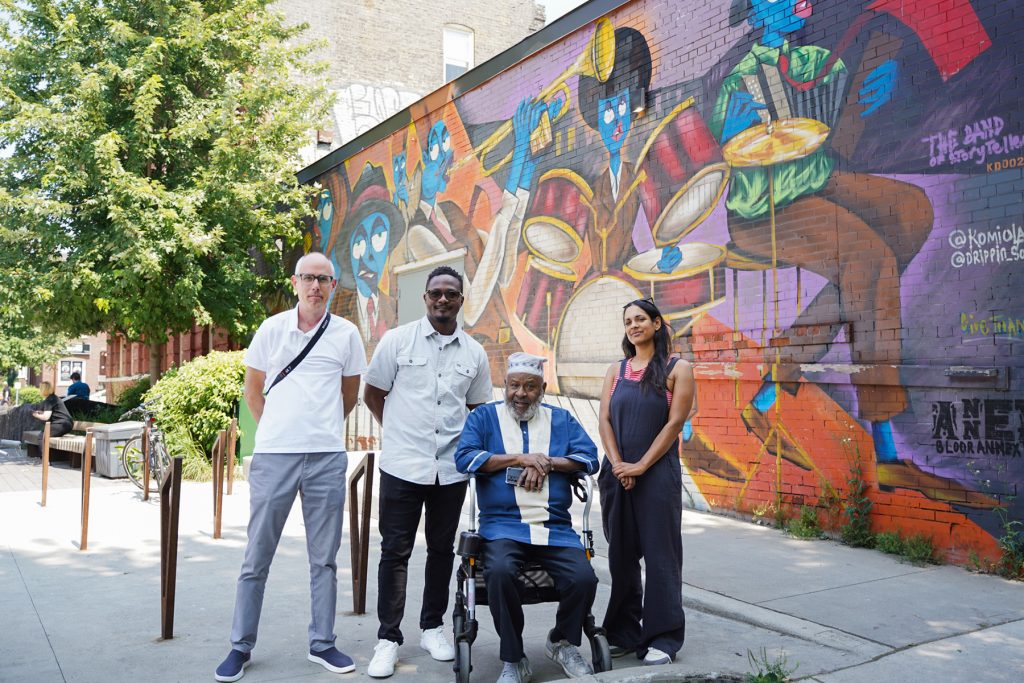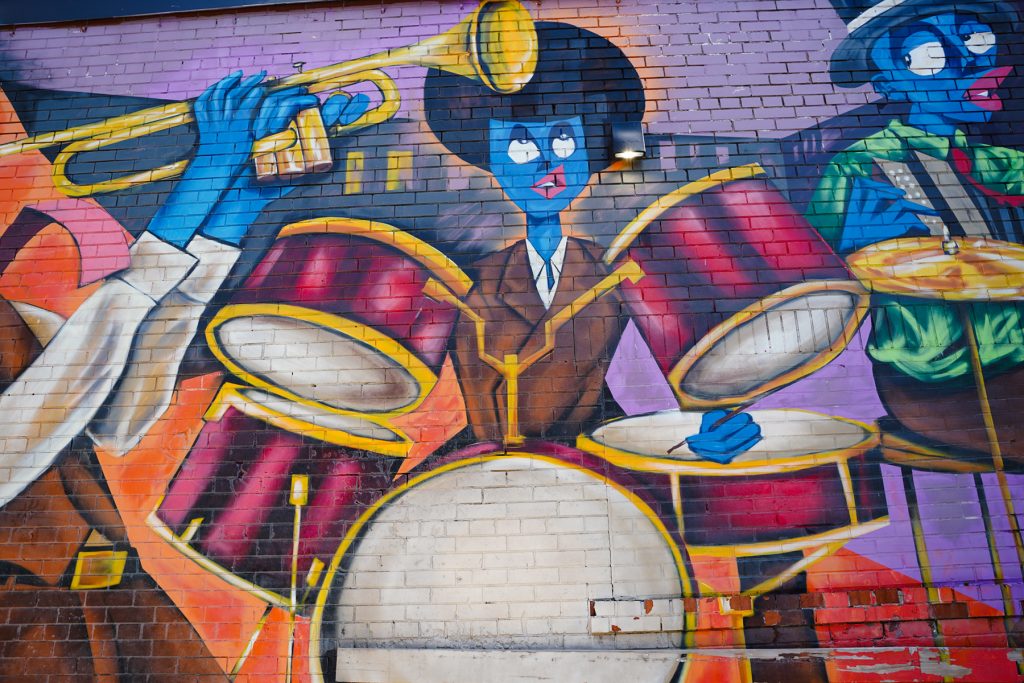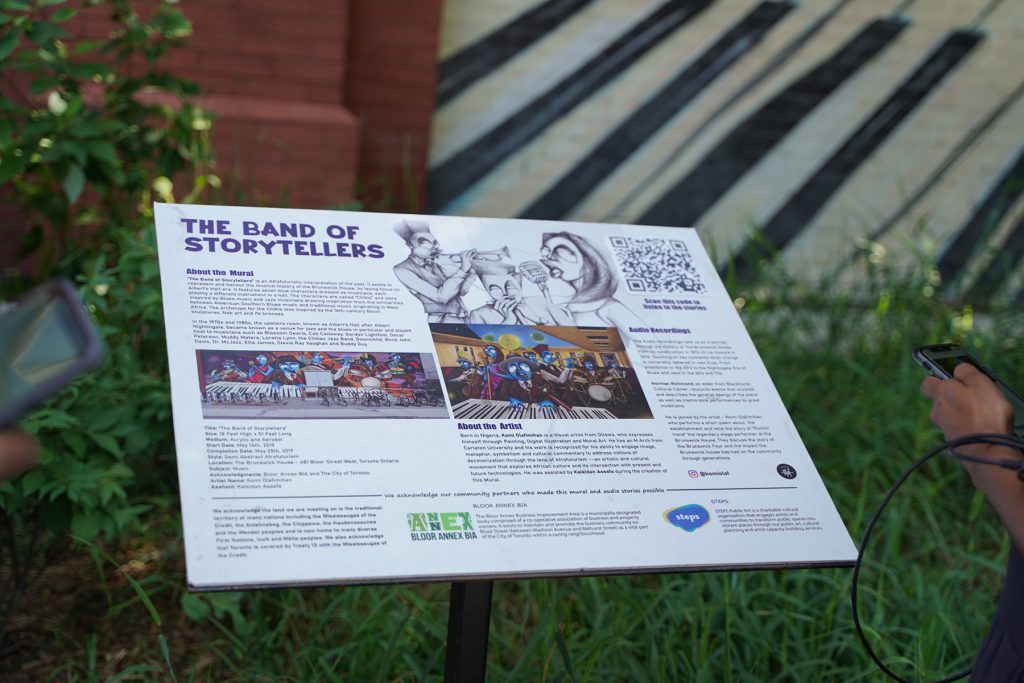Brunswick House mural an Afrofuturistic tribute to Albert’s Hall

By Ammara Khan and Meredith Poirier
Recent pruning in the parkette on the southeast corner of Bloor and Brunswick has shed new light on the colourful Band of Storytellers mural. The art provides an immersive understanding of the musical history of Albert’s Hall.
The Band of Storytellers mural was installed in 2019 and is a perfect backdrop to the popular the Bloor Annex Business Improvement Area (BIA) parkette. It pays homage to Albert’s Hall in the Brunswick House which was popular in the 1970s and 80s and was active for decades.
Komi Olafimihan was the artist who designed and executed the piece, along with the assistance of his friend, Kalkidan Assefa.
“When the callout went out for a mural for the Brunswick House, I really felt drawn to the idea of the musical history because a lot of great blues and jazz musicians, and Canadian legends, played specifically in that location,” said Olafimihan.
The mural was dedicated to the venue which existed above the Brunswick House.

COURTESY AYESHA KHAN/STEPS PUBLIC ART
The upstairs room was known as Albert’s Hall after Albert Nightingale. It was a venue known for jazz and blues, and hosted many renowned artists like Blossom Dearie, Cab Calloway, Gordon Lightfoot, Oscar Peterson, Muddy Waters, Loretta Lynn, the Climax Jazz Band, Downchild, Blind John Davis, Dr. McJazz, Etta James, Stevie Ray Vaughan, Buddy Guy, Jeff Healey and k.d. lang.
While representing the rich history of an important local landmark, Olafimihan’s piece simultaneously includes many more aspects to unpack.
Themes of Afrofuturism can be observed in this piece of art. Olafimihan speaks of a “schism between different African cultures.”
The pianist in the mural can be seen with his lips being pulled apart by an invisible thread, pointing to the idea of “speaking out” on this schism.
“The Africans and African Americans in the diaspora, the Africans in the Caribbean, the Africans in Brazil. Our Africanness manifests in different ways, but there is a schism, you know, so when I say these guys are Afrofuturistic, in a way, it’s imagining that schism being healed.”
Additionally, hidden in the keys of the mural’s piano, Olafimihan planted little NFC chip stickers which android users can read using their phones.
Those chips were initially linked to “different kinds of songs or videos of people that have played in Albert’s Hall or people that contributed to the blues or something to tie in with the history.”

COURTESY AYESHA KHAN/STEPS PUBLIC ART
The sign which now accompanies the mural is a newer addition and makes the art more immersive, interactive, and accessible. The audio accompanies the visual images and helps to unravel the cartoonish style of the images.
“It’s kind of a separate project,” said Melanie Ramsey, project coordinator for the BIA about the sign. “So if you are visually impaired or can’t be there in person, you can actually hear Komi describe this mural in an accessible way, which is very cool.”
The Bloor Annex BIA was awarded a STEPS Public Art’s Innovative Award, for the audio project. Ramsey decided to work with Olafimihan again, but in a new way, which would bring his other artistic mediums to light, like poetry and writing.
The BIA also worked with Norman Richmond, who actually lived in the area and used to visit Albert’s Hall. Norman has a strong music background, so he was actually able to kind of relive some of the times he went to this source.
Richmond shares his personal experiences living in the Annex in the 1960s and the cross-cultural connections being made across immigrant groups at the time.
These audio stories are accessible through a QR code on the sign next to the mural. The recordings allow you to immerse yourself in the history of the space where you sit and around the mural. Not only are the engaging stories full of information but they are paired with background sounds and music allowing you to further breathe in and live the stories. The audio tours also give listeners an introduction to Afrofuturism as an art movement and Olaf’s cartoon art style.
The recordings also include Olafimihan reciting a poem that he wrote about Albert’s Hall. The audio stories are incredibly immersive, and with soft jazz playing in the background and Olaf’s keen storytelling, listeners can really picture themselves in the iconic Albert’s Hall.
The sign project also aligns with the Bloor Annex BIA’s new focus on accessibility.
“You’re not just painting a mural and walking away…these are really beautiful pieces. So just, you know, [we are] building on these very cool things which are promoting more engagement and obviously more accessibility,” said Ramsey.
The Annex has benefitted from these projects and the results are a decline in graffiti in the “improved and beautified places.”
The BIA appreciates feedback from the community on the developments of projects and how they can work on making the Annex more accessible for people with disabilities.
Listening to the audio stories while standing in front of the mural will provide the best experience and will give individuals insight into the artistic inspiration for the mural. Head over to 481 Bloor St. W. with your smart phone and take in the art and the history.
READ MORE
- NEWS: Parkettes win Urban Design Award (Fall 2023)
- NEWS: Value Village Boutique takes over former Brunswick House site (Feb. 2023)
- ON THE COVER: New mural in the Annex (Jan. 2023)
- FOCUS: Bloor Street BIA parkettes win prestigious design award (Jan. 2023)
- NEWS: New mural celebrates Indigenous storytelling (July 2022)
- NEWS: Mural reveals eco-anxiety (June 2021)
- NEWS: Brunny Rexall to shutter (May 2021)
- ON THE COVER: Renewing Martel’s vision (Nov. 2020)
- LIFE: Paying homage to local characters (Oct. 2020)
- NEWS: New mural for Major (Dec. 2019)
- ON THE COVER: Laneway lit up (October 2018)
- CHATTER: Larry Sdao receives Community Builder Award (July 2017)
- NEWS: Restored Brunswick House reopens (May 2017)
- CHATTER: Painted streets launch in Kensington (SEPTEMBER 2016)
- ON THE COVER: An Annex bee celebration (JULY 2016)
- NEWS: Rexall replaces Brunswick House (April 2016)
- NEWS: Brunswick on the block (December 2015)
- NEWS: Ossington laneway gets a mural makeover (Aug. 2012)
- NEWS: Façade facelift: Lee’s Palace iconic mural is back (Nov. 2010)
